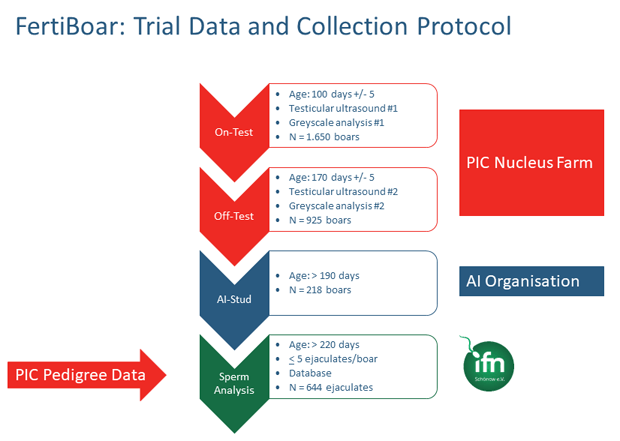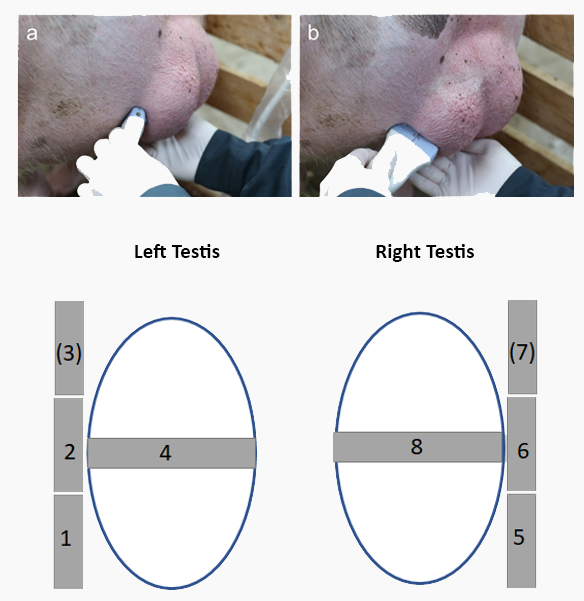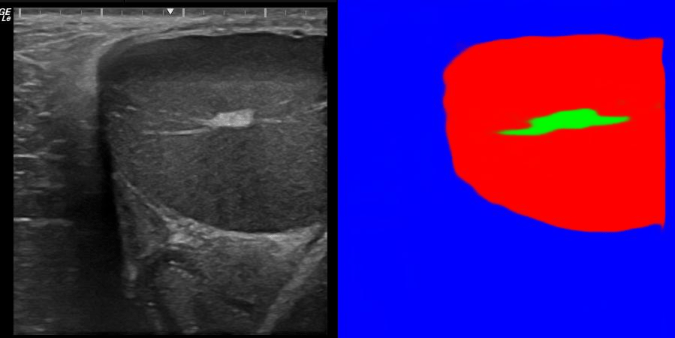A success story of applied research
New ways of predicting sperm quality and output performance in young artificial insemination (AI) boars are important for breeding companies to ensure that the pubertal boars delivered to the Gene Transfer Centres (GTCs) have a high chance of meeting minimum quality standards to be used for insemination and therewith dissemination of desirable characteristics.
The concept of the Fertiboar technology was developed in collaboration with IFN Schönow, an innovative research institute for livestock, during a 4-year intensive joint research project. Fertiboar Technology provides opportunities to predict boar semen quality based on testicular ultrasound measures prior to the first semen collection. With this technology boars with the best semen quality can be identified and selected for placement in Gene Transfer Centres. GTCs see benefit in terms of increased boar utilisation and commercial pig producers can expect improved semen quality and fertility rates.
A concept developed by the application of 3 innovative technologies
The FertiBoar software was developed and trained based on ultrasound pictures of over 1.500 boars and more than 500 associated ejaculate analyses. Two to three vertical and one horizontal picture were taken from each boars’ testicle during the On-, and Offtest procedure in addition to a width measurement to aid the testicular volume calculation (Graphic 1).


A software supported Grey Scale Analysis (GSA) was performed on all gathered pictures describing the testicular tissue texture through various pixel characteristics like the darkest/lightest pixel, the medium grey scale of the pixels and such. To automate this process and identify relevant regions for analysis within the testis, a convolutional neuronal network was trained to perform semantic segmentation (Picture 1 & 2).

Right picture = raw ultrasound picture.
Left picture = automatic differentiation between testicular parenchyma and other structures.

GTCs who received the boars were providing samples to an andrology reference lab to evaluate the quality of the harvested ejaculates. Based on this a boar was categorised as a satisfactory breeder if at least two ejaculates out of a series of five met the required quality standards.
The GSA data from the ultrasound analysis in combination with the spermatological data was used to program a supervised learning algorithm to predict weather a boar will produce ejaculates with satisfactory semen quality.
Exceptional Results
The decision model developed based on the trial data is capable of predicting >90% boars with poor semen quality correctly while the automation of the complete GSA analysis process enables large scale application of the technology. Further, the model is setup in a way that continuous feeding of the data will keep on improving the accuracy further.
A relevant advantage in boar efficiency
Data from Schulze et al. (2014) suggest that at 7-months of age (basically when semen collection and analysis of boars after delivery to the GTC starts) approximately 37% of all AI boars fail to pass minimum AI semen quality standards. The application of FertiBoar prior delivery of those animals going to the GTC would theoretically be capable of reducing that number to ~3,7% (note that some testicular damages might also appear after the selection of boars via FertiBoar).
A technology that benefits all participants in the pork industry
FertiBoar offers benefits for the applying breeding company as well as for the GTCs receiving tested boars and the pig farmer using semen doses of such boars.
Breeding company
FertiBoar helps breeding companies to ship boars with a higher likelihood for successful usage in GTCs. Thus, a better rate of genetic dissemination and faster realisation of genetic progress at the customer level are achieved. This becomes even more relevant in business realities where only a limited number of AI boars can be delivered each year for genetic refreshment of the herd (boar exports to countries with strict import regulations).
GTC
By using FertiBoar selected animals, the GTC would become even more efficient in introducing boars to the system that will be suitable for use in AI. In consequence, boar quarantine costs per working boars could be reduced significantly while the GTCs semen output per inventoried boar would increase.
Example:
Reducing boar fallout rate in a 300 head GTCs and 65% annual replacement rate with £850quarantine costs from 20 to 5% equals potential savings of ~£24,521 per year.
If boars stay in the GTC for 10 weeks prior poor semen quality is identified/confirmed and culling is executed, the above scenario reduces the productive annual boar inventory by >5 resulting in an opportunity loss of semen dose production equalling approx. ~10.000 doses p.a. (assuming 2000 doses annual production per boar).
Sow farms
Overall, the application of FertiBoar improves the number of boars with good semen quality as well as the average semen quality of the herd as well. As semen quality is linked to farrowing rate and litter size, sow farmers will benefit from FertiBoar indirectly as well.
An example of practical innovation applied to commercial production
The FertiBoar technology has been implemented in the first boar multiplier in Germany for routine use in June 2021. The first fully tested animals are due to be delivered to customers in September 2021. After a process of fine-tuning processes and optimizing data logistics, it will be rolled out to additional boar multipliers in Europe over the course of next year.
Key points about Fertiboar
FertiBoar enables the early identification and negative selection of AI boars with expected poor semen quality. The technology uses testicular ultrasound pictures to automatically analyse relevant organ sections using convolutional neuronal network and semantic segmentation approaches and describe the functional tissue characteristics via Grey Scale Parameters. This information feeds a classification algorithm to predict a boars’ capability of producing good semen quality later in life. The technology offers advantages throughout the value chain by:
- Enhancing the breeding company’s ability to enable genetic dissemination
- Raising the GTCs overall semen production efficiency per purchased boar
- Delivering higher quality semen to pig farmers with respective fertility implications
Sources
Resende PCSL, Siqueira AP, Rodrigues LC, Lagares MA, Chiarini-Garcia H, Almeida FRCL. Relationship between pre-pubertal biometrical measures and sperm parameters for the selection of high genetic merit pure and crossbred boars. Theriogenology 2019;127:1-6.
Robinson JA, Buhr MM. Impact of genetic selection on management of boar replacement. Theriogenology 2005;63:668-678.
Schulze M, Buder S, Rüdiger K, Beyerbach M, Waberski D. Influences on semen traits used for selection of young AI boars. Anim Reprod Sci. 2014 Aug;148(3-4):164-70.
Schulze, S. Beyer, F. Beyer, R. Bortfeldt, A. Riesenbeck, C. Leiding, M. Jung, M. Kleve-Feld. Relationship between pubertal testicular ultrasonographic evaluation and future reproductive performance potential in Piétrain boars, Theriogenology 2020;158:58-65.




